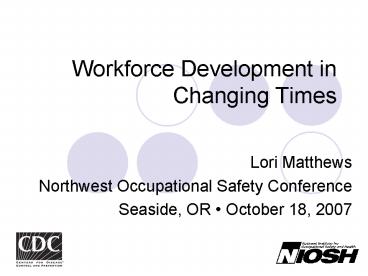Workforce Development in Changing Times - PowerPoint PPT Presentation
1 / 14
Title:
Workforce Development in Changing Times
Description:
Management, professional. 50.4. 9.6. 19% Service occupations. 23.8. 3.4. 14 ... Photographers. 94.8. Teachers aides. 91.8. Industrial engineers. 87.6 ... – PowerPoint PPT presentation
Number of Views:11
Avg rating:3.0/5.0
Title: Workforce Development in Changing Times
1
Workforce Development in Changing Times
- Lori Matthews
- Northwest Occupational Safety Conference
- Seaside, OR October 18, 2007
2
The face of the American worker is changing. . .
3
Overview
- Generational shifts in workforce
- Recruiting and retaining workers
- Preserving expertise of baby boomers
- Summary points
4
Source http//www.census.gov/population/socdemo/a
ge/2006older_table11.xls
5
Age Distribution for All Industries and Coal
Mining 2003
Coal Mining
All Industries
55 years
lt25 years
55 years
lt25 years
25-34 years
45-54 years
25-34 years
35-44 years
45-54 years
35-44 years
Source http//www.cdc.gov/niosh/mining/highlights
/programareahighlights15.htm
6
Generational Shifts
- Baby boomers are retiring
- 25 of total workforce
Source Retirement concerns, 2007
7
Source Bureau of Labor Statistics, 2000
8
Generational Shifts
- Generation X (1965-1979)
- Echo-boomers (1980-1995) 80 million
- Generation Y or Millennial
Source Marston communications, n.d.
9
Turnover Rates
- Retail industries have 60 annual turnover
Source More help wanted, 2005
10
Recruitment Strategies
- Move past recession mindset
- Permanent job opportunities
- Creativity and change
Sources Marston, C., 2007 Vivian, K., 1999
11
Retaining Workers
Source The baby boomer exodus, 2006
12
Preserving Expertise
- Capturing the wisdom of veteran workers
- Identify and document knowledge and experience
- Succession planning
Source The baby boomer exodus, 2006
13
Summary Points
- Preserve expertise of experienced workers
- Meet needs of younger generation
- Establish mentoring relationships
14
References
Occupation group of the employed population 55
years and over in the civilian labor force by sex
and age 2006. (2006). US Census Bureau.
Retrieved October 6, 2007 from http//www.census.g
ov/population/socdemo/age/2006older_table11.xl NIO
SH mining safety and health research Training
highlights. (n.d.). Retrieved October 4, 2007
from http//www.cdc.gov/niosh/mining/highlights/pr
ogramareahighlights15.ht.m Retirement concerns
for baby-boomers. (2007). AccountingWEB.com.
Retrieved October 1, 2007 from http//www.accounti
ngweb.com/cgi-bin/item.cgi?id103085d883h884f
882dateformat25o2025B2025Y Marston
communications. (n.d.). Retrieved October 1,
2007 from www.marstoncomm.com Marston, C.
(2007). How to manage employees from younger
generations. Retrieved October 13, 2007 from
http//www.allbusiness.com/human-resources/workpla
ce-health-safety/4353305-1.html More help
wanted Older workers please apply. (2005). The
New York Times. Retrieved October 14, 2007 from
http//media.bordersstores.com/pdf/nytimes_32305.p
df The baby boomer exodus Retaining knowledge
and experience after retirement (2006).
Performance Agents Replicating your Top
Performers. Retrieved October 10, 2007 from
http//www.frmbc.org/newsletter/Whitepaper_BabyBoo
merExodus.pdf Vivian, K. (1999). A swipe file
for practice office recruiters. Retrieved October
12, 2007 from http//www.users.cloud9.net/kvivian
/html/feature__recruiting_tips.html
15
(No Transcript)































